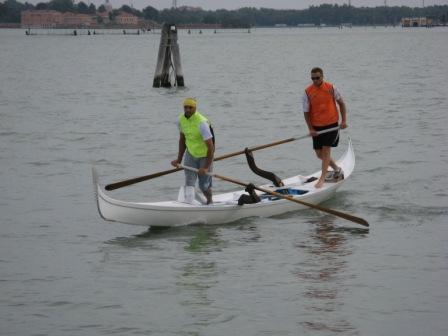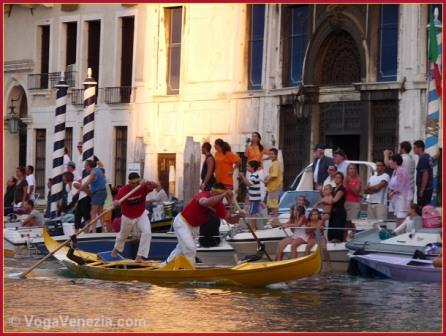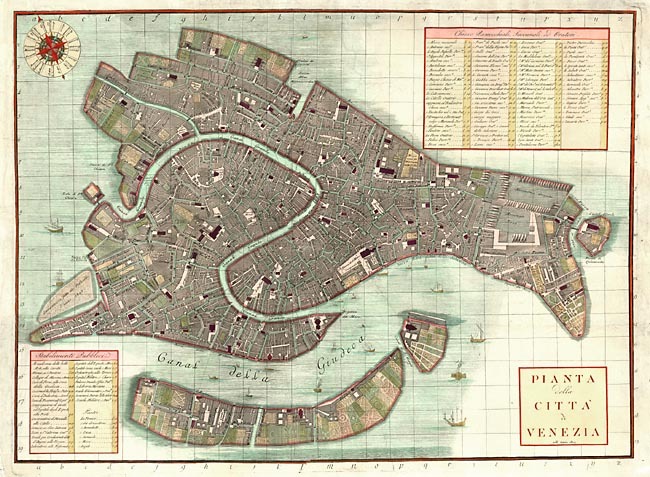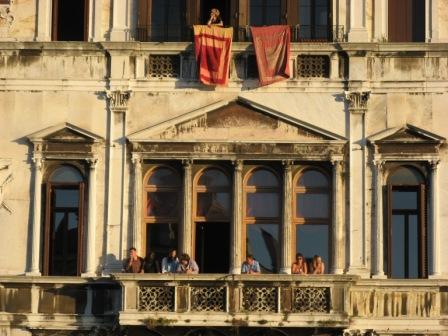On the first Sunday of September, one of the biggest events in the Venetian entertainment calendar (and absolutely the biggest one in the Venetian rowing calendar) takes place: A series of races in the Grand Canal known collectively as the Regata Storica, or Historic Regata.

It’s hard to explain why this might be important to anyone without providing a great deal of background, stretching back one, two, five, 20, and eventually 700 years. I would love to provide all that, and at some point I probably will, but for now I merely want to say that if you happened to hear an unexpected explosion yesterday, wherever you are (I’m imagining something similar to the sound of Mount Pelee’ erupting), that would have been the hopes, ambitions, sacrifices, passions, and dreams of two mighty men being blasted to eternity, despite the fact that it wasn’t fire, but water, that was the obliterating agent.
The immediate aftermath — continuing in the aural mode — was the sad, persistent wheeze of the air seeping out of the hopes, ambitions, etc. of two other men who were the immediate beneficiaries of the disaster, but who were men who also had spent a year preparing for a battle to the death and who realized as soon as they saw their adversaries swimming that none of the four them was ever going to be able to say which of the two pairs of competitors really was the best of them all.
This sad wheezing sound was amplified by the disappointment of all the spectators who had been thoroughly worked up about the event because they (including me) had spent years watching these two pairs of men turn each race into something gladiatorial. Over the years there has been rage. There has been bitterness. There has been euphoria. And now there has been a win with no victory, a loss with no excuse. “No contest” may sound great in a court of law, but it’s a calamity for athletes and spectators alike.
Venetians have been racing boats forever. At first there were hundreds of men aboard galleys racing across the lagoon, a practice organized and encouraged by the Venetian government in order to ensure that there would be enough seriously trained rowers ready at all times for whatever naval battles might be coming up. This would be roughly from the year 900 to 1300 AD.
Smaller races began to proliferate as the fruit (wealth and power) of the said naval battles began to give Venice many reasons and occasions to show its most important visitors how very rich and strong it was. The most spectacular of these races were performed on one of the world’s most spectacular stages, what Venetians call “Canalazzo,” or the Grand Canal.
I will tell you more some other time about the history of racing, boats and champions, the way the races have changed in the past generation or two, and much more which I find irresistibly fascinating. But for now, let’s get to the men in the water.

The most important race of all races is the last one of the day, which pits pairs of men on the racing gondola, or gondolino, against each other. This is the only race in which this boat is used, and it is only raced by men. Generations of boys have slaved at working their way up through the racing ranks to reach the pinnacle which is this event, something so important that even to have failed in the eliminations is a strange source of pride.
Why is it so important? Yes, there is a money prize, but each official race awards money to the competitors. Yes, there is a pennant — red, white, green, and blue — to the respective racers finishing first, second, third, and fourth. (The following five boats get the swag but nothing more.) As with many competitions, the ones who win also get all the adulation, envy, and awe that they could ever want, spiked with the dangerous drug which is the insatiable desire/need to win again. And again. And again.
The most powerful lure of the Regata Storica is that whoever wins this race five times in a row is glorified with the Venetian equivalent of the laurel wreath, the bull’s ears, the green jacket, and the America’s Cup, which is the title “Re del remo,” or king of the oar. It sounds fruity in English, but it is so fiendishly hard to win five times in a row that I have to say that anybody who can do it deserves whatever he wants. The last pair to accomplish this feat was Palmiro Fongher and Gianfranco Vianello in 1981. And yesterday was Year 5, the day of glory, for Team A.

Team A: Ivo Redolfi Tezzat and Giampaolo D’Este, who is commonly referred to as “Super D’Este” or “the Giant” because of his physical size and athletic prowess. They have won this race each year since 2005.
Team B: Rudi and Igor Vignotto, cousins who are known as the “Vignottini,” or “little Vignottos,” as they hail from the island of Sant’ Erasmo where theirs is one of the most common last names and this nickname helps distinguish them from the rest of their assorted rowing relatives stretching over generations.
The Vignottini had been within reach of this prize once (having won each year from 1995 to 1998, only to be defeated in the crucial fifth year by the same D’Este with a different partner). They started the count again in 2000 and got as far as 2003, when D’Este again stuck his oar in their spokes, so to speak. It just went on like this between them, back and forth, till nobody could stand it anymore, especially them, I’m guessing.
But D’Este and Tezzat were on a roll, having won each year from 2005-2008, and yesterday the moment of glory for which they had been striving seemed finally to be within their grasp. And everyone knew that not only did the Vignottini want to win, they wanted it with a fanatic determination I can hardly imagine in order also to savor the revenge of having ripped from their rival’s hands the very honor which those rivals had ripped from theirs.
It was going to be big.

We were all sitting in the gondolone, tied to a piling in the Grand Canal along with a slew of other boats, waiting for this. The race began at 6:00 PM, and usually takes about 35 minutes to run its entire breakneck course from the Giardini across the Bacino of San Marco, up the Grand Canal to the railway station, around a temporary piling and back down the Canal to the “volta de canal,” the traditional finish line in the curve of the canal at Ca’ Foscari.
Being as we were parked near the finish line we didn’t see the disaster, which occurred far away toward the entrance to the Canal, but we heard the incredulous voice of the announcer suddenly saying, “The blue boat has capsized!”
Here is the only bit of video which I’ve been able to find of this epochal instant (evidently everybody was looking somewhere else at the moment). You see, from left to right, the brown boat (Vignottini), blue (D’Este-Tezzat) and green. Look carefully at the right edge of the screen and at second 18 you can see the splash (helpfully highlighted by the sun) of Tezzat’s plunge from the stern; you see D’Este struggle to keep the boat stable, then at second 48 he falls and the blue hull capsizes.
watch?v=P62kXdfaiD8
Impossible to conceive that something like this could happen to these two paladins (water? isn’t that what they walk on?), instantly followed by the inconceivable idea that they were actually out of the race. Not because they’d been disqualified, but merely because by the time they’d have gotten the boat floating and raceable again, it would have been time to go home anyway.
Rumors immediately began to buzz. Clearly the Vignottini weren’t guilty of anything tricky, because they had almost immediately taken the lead and were several boat-lengths ahead when this happened. But had it been the green boat, which had been coming up on the left? Was it deliberate? Was it an accident? If it was an accident, how the hell could such a thing happen?
As questions crashed around in everybody’s overheated brains, the Vignottini rowed the entire course pretty much on cruise control, far enough ahead of the rest of the herd that there wasn’t much need to think about much else than where they were going to have the party. Because by then they knew that the entire island of Sant’ Erasmo was going to be dancing in the streets (I think there are two), not only because of their obvious victory but because the victors of the women’s race and the boys’ race were also from Sant’ Erasmo. In fact a friend of mine told me that as soon as it was dark, fireworks began to flare over the island.
We spectators, though, were sitting there feeling like somebody had just shut off the lights and left the building. An emotion which I have no doubt the Vignottini were also feeling, at least a little. And D’Este and Tezzat as well, as they were pulled into motorboats and taken away, shortly thereafter to be photographed in dry clothes but wet with tears.
Here is what happened, according to some authoritative sources (not the victims, of course, who immediately began to cry “foul” even though there was no sign of any such thing).
First, the starting line-up. D’Este and Tezzat knew they were going to have a bear of a race on their hands because of their position at the start. The Vignottini had a great position, D’Este not so much. When you’re racing in the lagoon, you’re dealing with factors even more challenging than your boat and your adversary, you’re dealing with the tide. Unlike swimming pools or crew basins, the lagoon is always moving, and not uniformly, either.
The positions are drawn by lot precisely because of this reality, to avoid any possibility of favoritism. Seeing that the tide was going out at 6:00 PM yesterday (and very powerfully, because the moon was just past full), everyone was starting out against the tide, but those closer to the shore were more handicapped by the outflow than those at the end of the lineup, out in the middle of the Bacino of San Marco. This is because the water moving out from the Grand Canal and the Giudecca Canal hits against the shoreline at the Giardini (because the shore is curved) and then does a sort of turn back upstream, thereby creating some forward-moving current for the people who are further out. Like the Vignottini.

I know this from personal experience, as I participated in a race years back in the Canale delle Navi which has a pretty strong flow with the incoming tide. Except that I was second from the shore, so I was facing the same turnaround phenomenon mentioned above. Thus the rowers out in the middle of the canal were flying away, and I, as the saying here goes, am still rowing. As Lino says, the “number in the water” can really punish you.
To prevent total anarchy, each boat is required to stay in its lane for 164 feet (50 meters), at which point the leaders and followers are supposed to be sufficiently far apart to allow for maneuvering without dangerous craziness. The dynamic is very much like a horse race, supposing that the horses had to stay in their lanes for the first ten seconds.
Second: Tension and human error. Tezzat (rowing astern and also steering the course) was obviously feeling the pressure. I can say that because who wouldn’t? The Vignottini were ahead but Tezzat hoped to overtake them, except that he couldn’t do it on their right because the entrance to the Grand Canal is relatively narrow and he would have found himself bottled against the pilings on the right and then running straight into a vaporetto dock. So he and D’Este slowed down for an instant to drop behind the squeezing boat and pass it on its left.
So far, so fine. But as soon as Tezzat did that, he discovered the next boat over on his left, the green gondolino, was moving rightward and on a potential collision course with him. So he instantly made a counter-stroke to turn his boat slightly to the right, out of the path of danger. He was already rowing pretty hard, because he was working against the tide, as I mentioned.
It was a matter of nano-seconds. The force of his counter-stroke was just a little too hard and his oar popped out of the water, throwing him off balance — just enough so that on a moving boat he couldn’t get it back. He fell overboard but the boat, obviously, kept going. This sudden unbalanced trajectory meant that D’Este, in the bow, lost his balance, because he wasn’t prepared for his boat to suddenly shift under him. He tried instinctively to correct the forces of gravity, inertia, momentum, whatever all that stuff is, but the boat had already taken on some water from its first swerve over onto its side and over he went, taking the boat over with him.
The word “over” is probably one which will never be uttered in the D’Este and Tezzat households again, for any reason. Because at that point everything was over. The Vignottini had debuted in “Canalazzo” in 1991, after years of rowing at the more junior levels. D’Este’s debut in “Canalazzo” was in 1992; Tezzat’s in 1994. They had all been facing off five times a season, on different boats, in different parts of the lagoon, for nearly 20 years. That’s roughly a hundred races, if I’m not wrong. And now that the five-year count has begun again for D’Este and Tezzat, it’s physically unlikely that they will be at peak form, as they were yesterday, the next time they could hope to have another chance at the title.
It’s over for the Vignottini, too, but in a happy way, even though this isn’t the happiness they’d dreamed of. They finally did it, but their joy is deeply dented by the fact that they won’t ever be able to vaunt the deepest meaning of “re del remo” because they didn’t truly defeat their adversaries.
So they are all unhappy, to one degree or another, including the men on the green boat (remember the green boat?) who did nothing wrong but who appeared to be the proximate cause of all this. Andrea Bertoldini, the stern rower of the pair, was near tears at the finish line. “Everyone is always going to think we’re to blame,” he said, th0ugh I suppose when people start to calm down they’ll see that he’s right.
So I was mulling all this over today, and feeling very bad as well for the wives of these guys, women who’ve also sacrificed years of family time for their husbands’ endless training sessions, not to mention sharing the tension and so on of every race. Frankly, I think being the wife of one of the two drowned rats must be as bad as being the rats, because there’s little that’s worse than seeing somebody you love in real pain and not being able to do anything to fix it.
On the other hand, these guys are as tough as Grape Nuts, and have competed in plenty of races over the years in which they’ve been penalized, demerited, suspended, etc. for all sorts of infractions and trickiness. Curses and insults fly. At least one — no names — has a bad reputation for spitting at his adversaries when they get too close. Or at least he used to. This is a game in which haloes don’t help you at all. In fact, they’re a serious handicap.
Third point: They tempted fate. Sorry, but you just can’t do this. Lino says, “Never underestimate your adversary,” and of course that’s true, but it only helps you if you haven’t reached the point where your mania to win overrides every other thought and instinct.
What I found out today was that the D’Este-Tezzat axis had long since booked the restaurant for the victory celebration party. They had it all planned out. And I’m thinking, That’s just crazy. Even I would know not to do that. The Venetians have a saying for it: “Don’t calculate the bill without consulting the barkeep.”
This extraordinary feat of confidence — and I admire confidence even when it’s not justified — is from a category of people (Venetian racers, male) who are known to be so superstitious that some of them won’t remove — or wash — certain articles of clothing which they are convinced bring them good luck. Why would they have thought they could flimflam the fates?
Luck — whatever that may be — is not a toy. Small children aren’t supposed to play with plastic bags, and grown men shouldn’t play with what they think the future is going to be. I thought we knew that. Now we know it again.


4 Comments
I’m confused – D’Este was looking for his 5th consecutive year this year but the Vignottini were looking for their 5th consecutive year in 2008 ???
According to your para above results were:
Vignottini 95 96 97 98
D’Este 99
Vignottini 00 01 02
D’Este 03
Vignottini 04 05 06 07
D’Este 08
so how was D’Este on his 5th year in a row?
Thank you for your close attention. How embarrassing for me, but this error demonstrates yet again that I must not work past 11 PM. I have amended the text to reflect the situation you so clearly explained. Will be more careful next time. I hope.
Thanks for the info – this will make watching the Ragata so much more interesting! We will be arriving in Venice the morning of September 5 2010 for a three-day visit. Would you be so kind as to tell me what time the parade/races begin? Any advice as to a vantage point to take in the races? I’m guessing most folks have a spot or boat staked out in advance …
The “corteo” (boat procession) usually begins at 4:00 PM. The races begin around 5:00, as I recall. You should be wherever you’ve chosen as your base fairly early before that as crowds begin to form at the few favored spots and the streets also.
What one might call a good vantage point depends on whether it’s important to you to see the finish. If not, you can see the procession and races from sitting on the steps of the basilica of La Salute at the entrance to the Grand Canal.
There are many small calli (streets) that open into the Grand Canal; some have little docks. Don’t know how much exploring you might feel like doing to find one.
Anyway, to orient you, the finish line is at the point on the Canal where the vaporetto stop is for “San Toma’.”
If sitting isn’t important to you, go really early and stake out a place on the Rialto Bridge — from this point you can see the race both going up the Canal and then the last sprint to the finish line.
You might ask at your hotel if there are tickets; the city sells seats on a few bleachers which they set up.
In any case, the most spectacular stretch of the Canal for the races and procession is between the Salute (or San Toma’) and the Rialto Bridge. Of course the races go all the way to the station but there are fewer onlookers, hence less excitement.
Hope this helps.